Audio beehive monitoring based on IoT-Ai techniques: A survey and perspective
Abstract
In beekeeping, monitoring beehives plays an important role in
making sure bee colonies stay healthy and in reducing negative
effects that could happen in the colonies. A large number of studies
have been carried out to improve the performance of monitoring
beehives from the traditional manual methods. Most importantly, the
application of artificial intelligence (AI) technologies in recent times
have led to significant effects in the monitoring process. These new
methods, however, have not yet been investigated or applied in
Vietnam. To understand the use of AI-based technologies in the
automatic monitoring of beehives, this paper provides a survey on
beehive monitoring systems based on audio data and AI techniques.
Opportunities and perspectives for the applications of these
techniques in audio-based monitoring beehive in Vietnam are also
discussed.
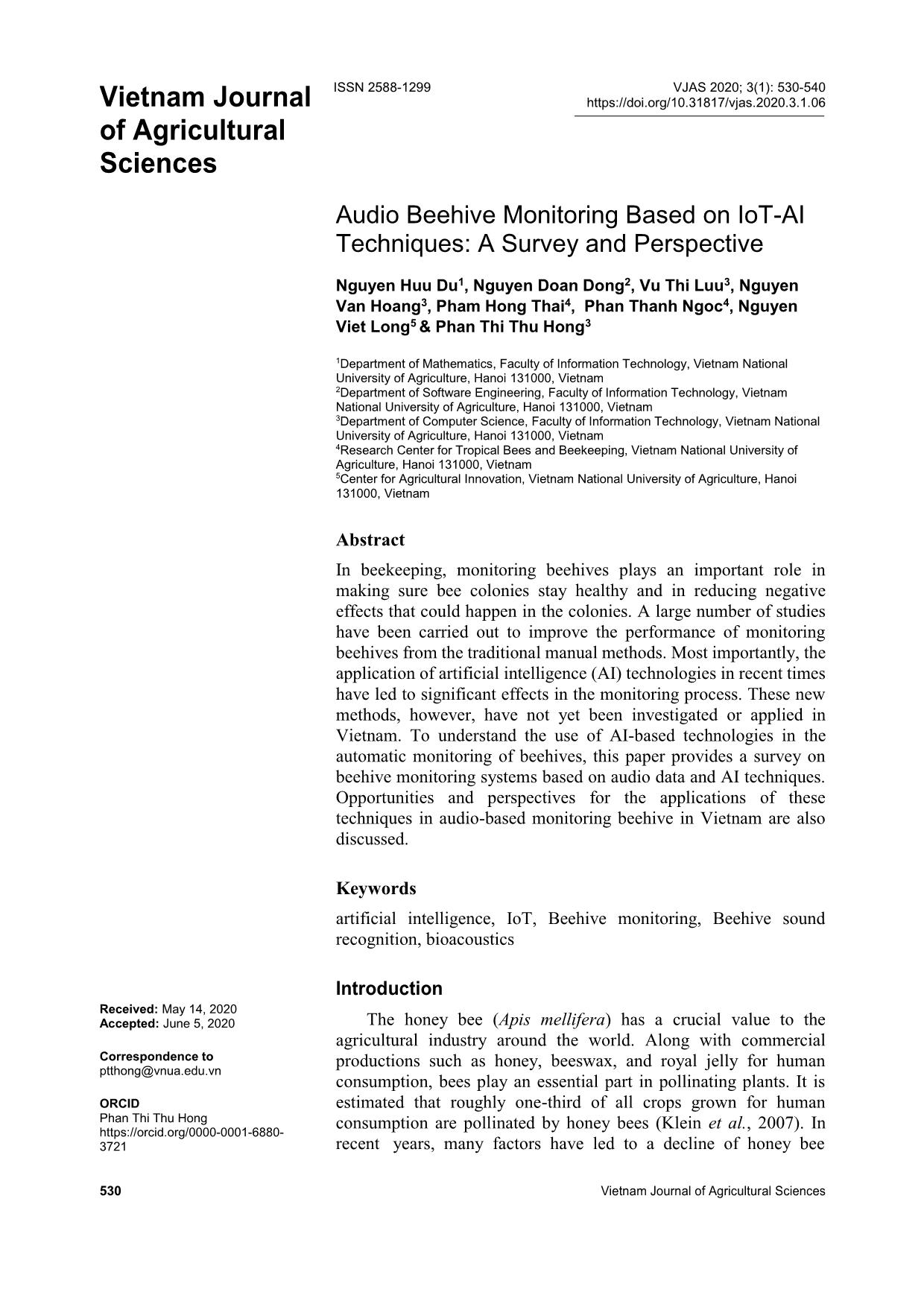
Trang 1
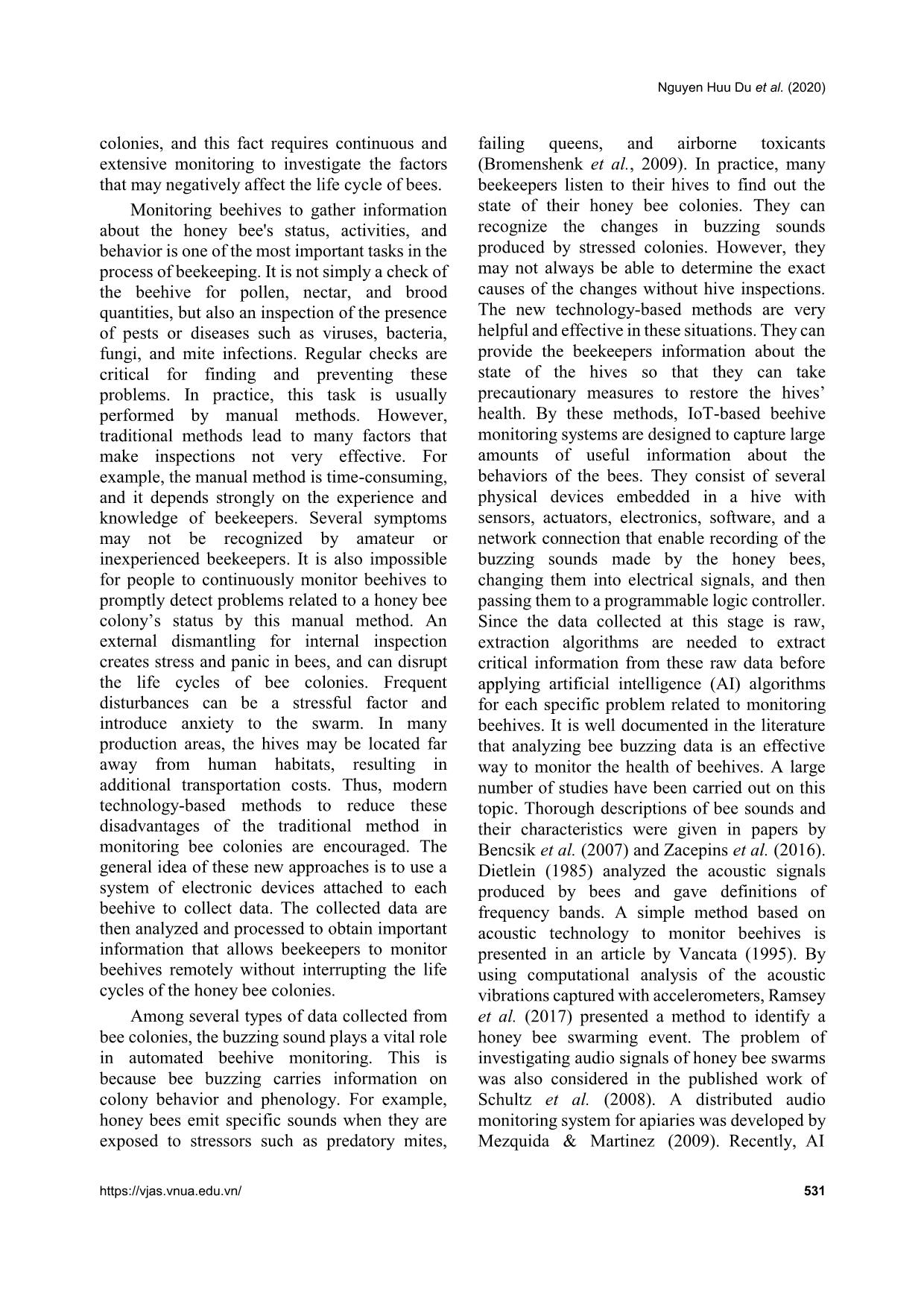
Trang 2
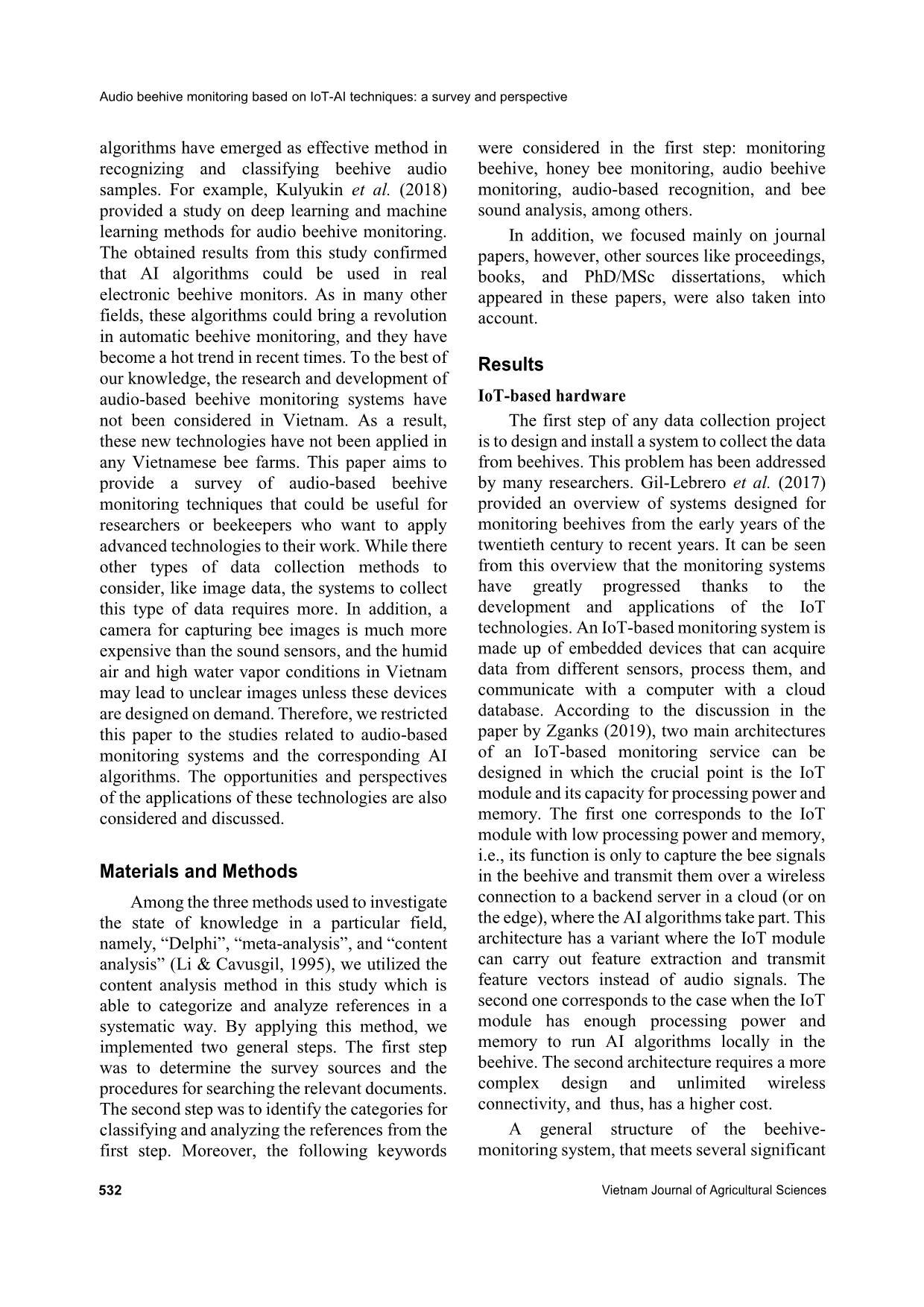
Trang 3
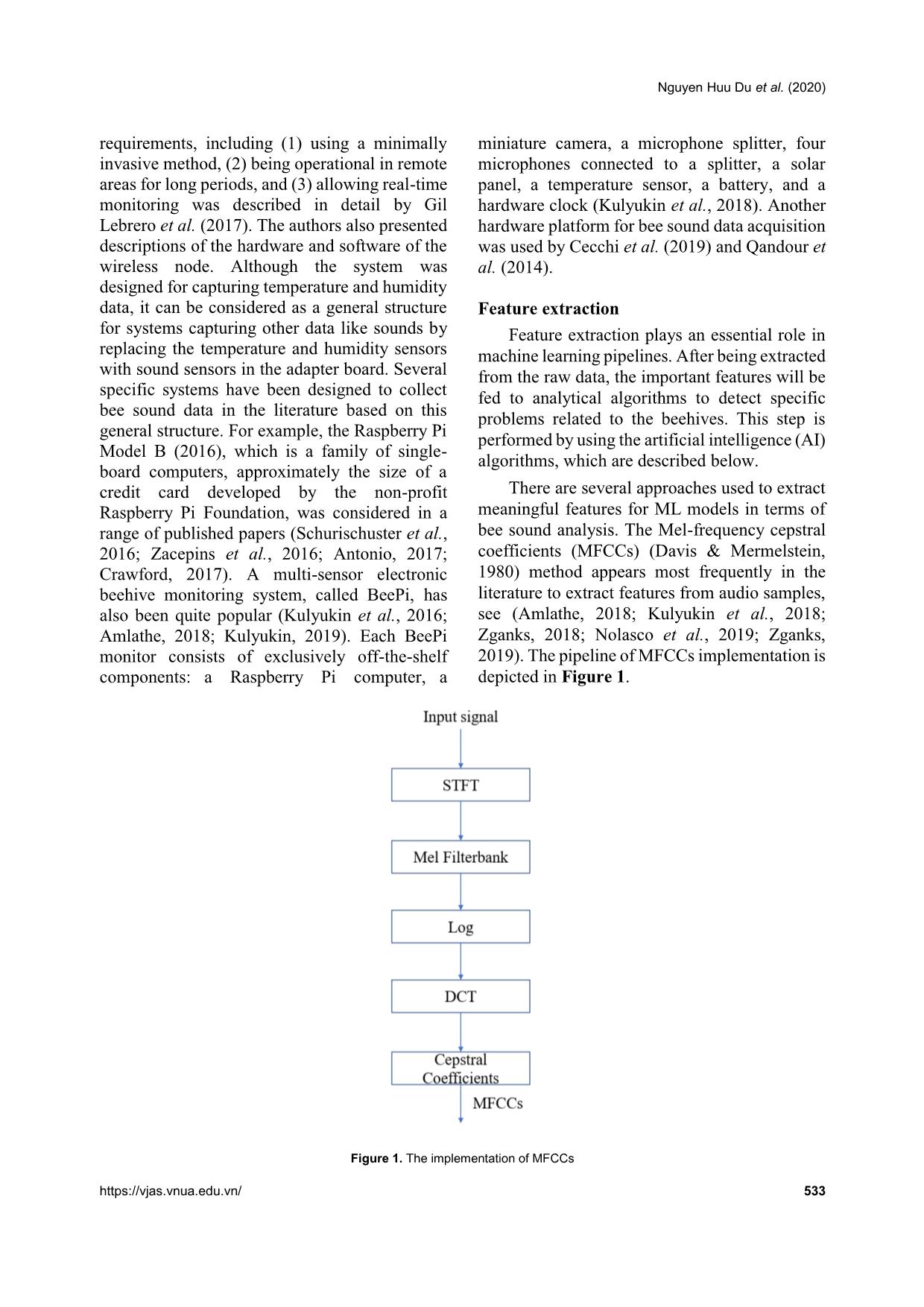
Trang 4
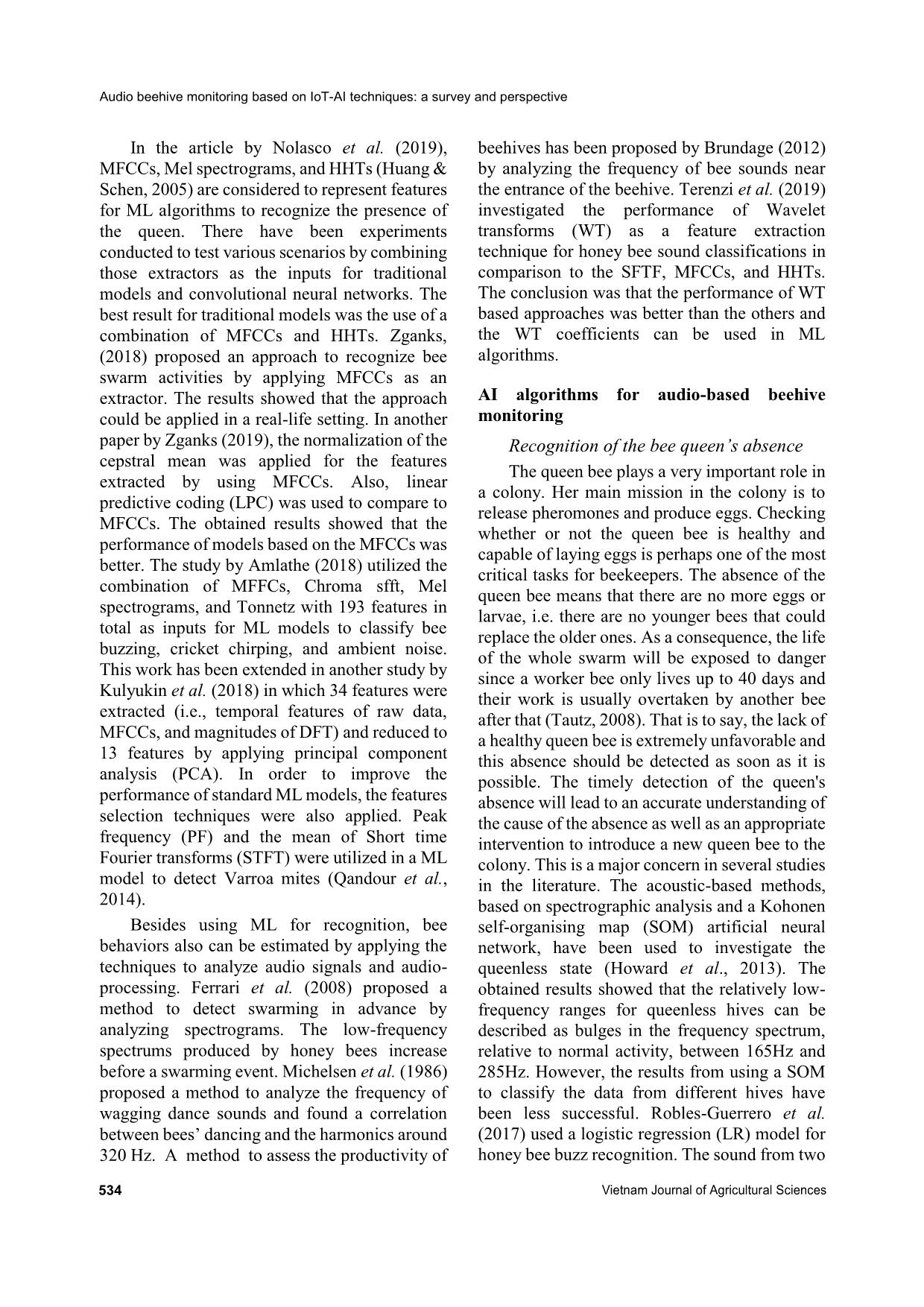
Trang 5
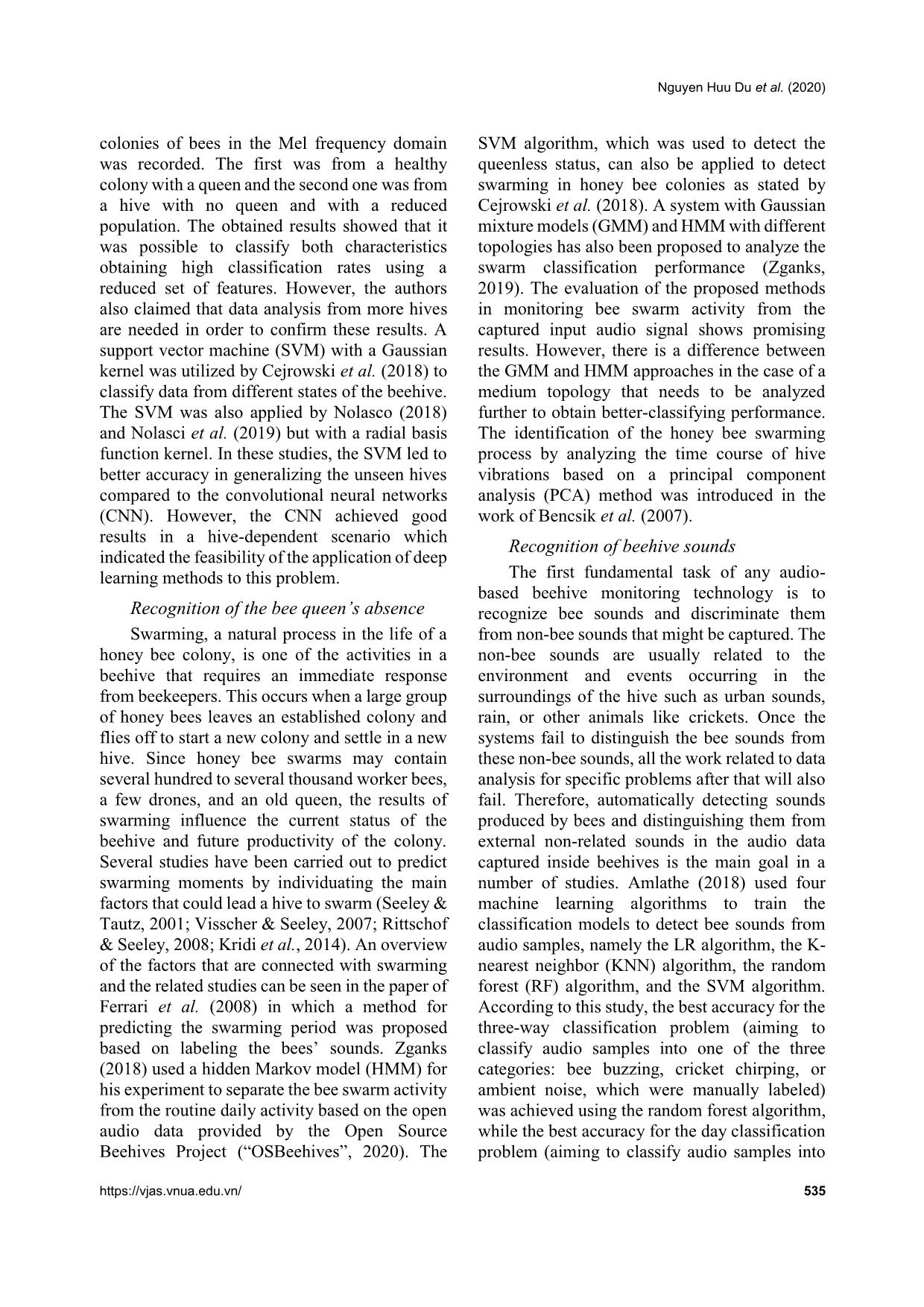
Trang 6
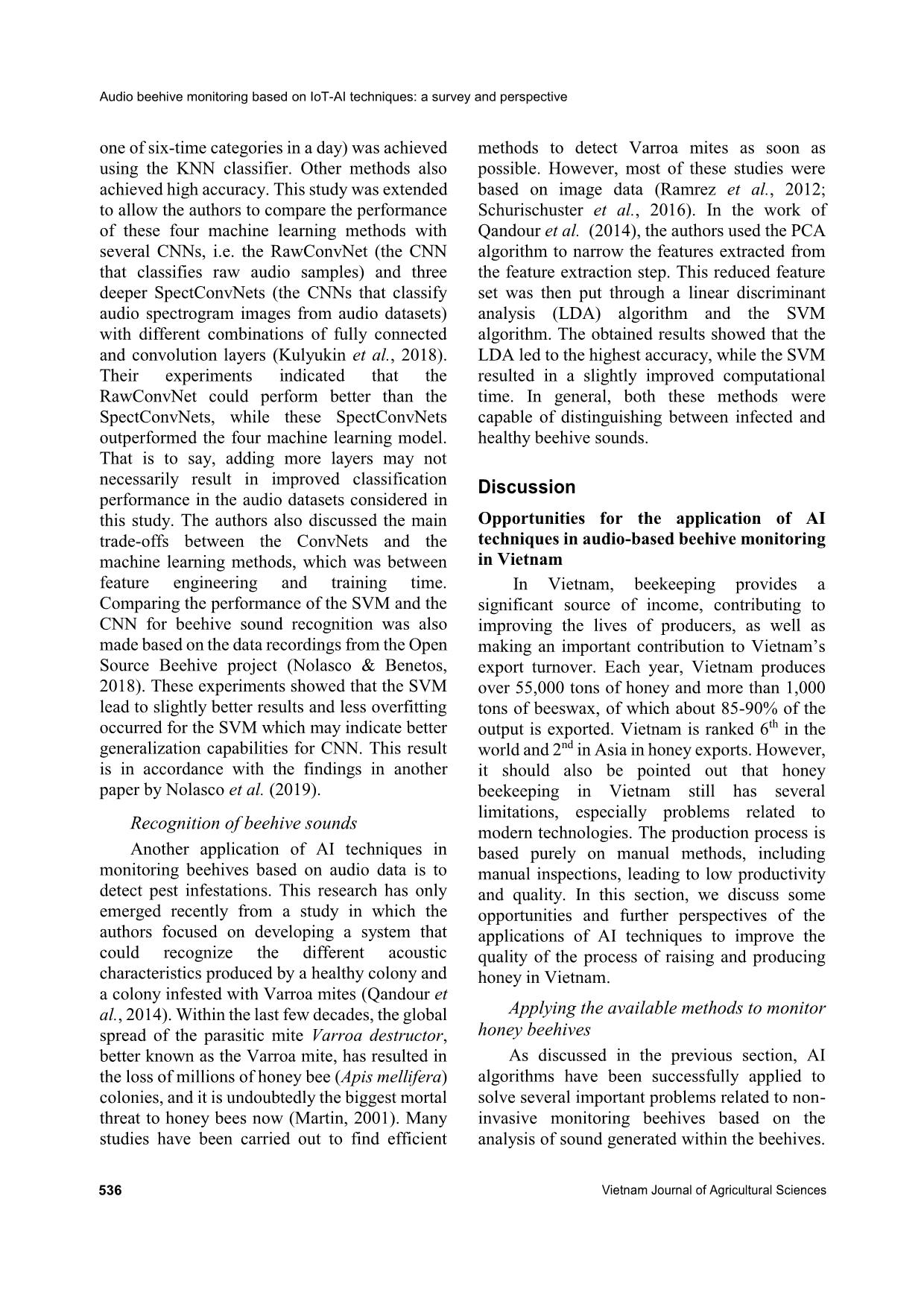
Trang 7
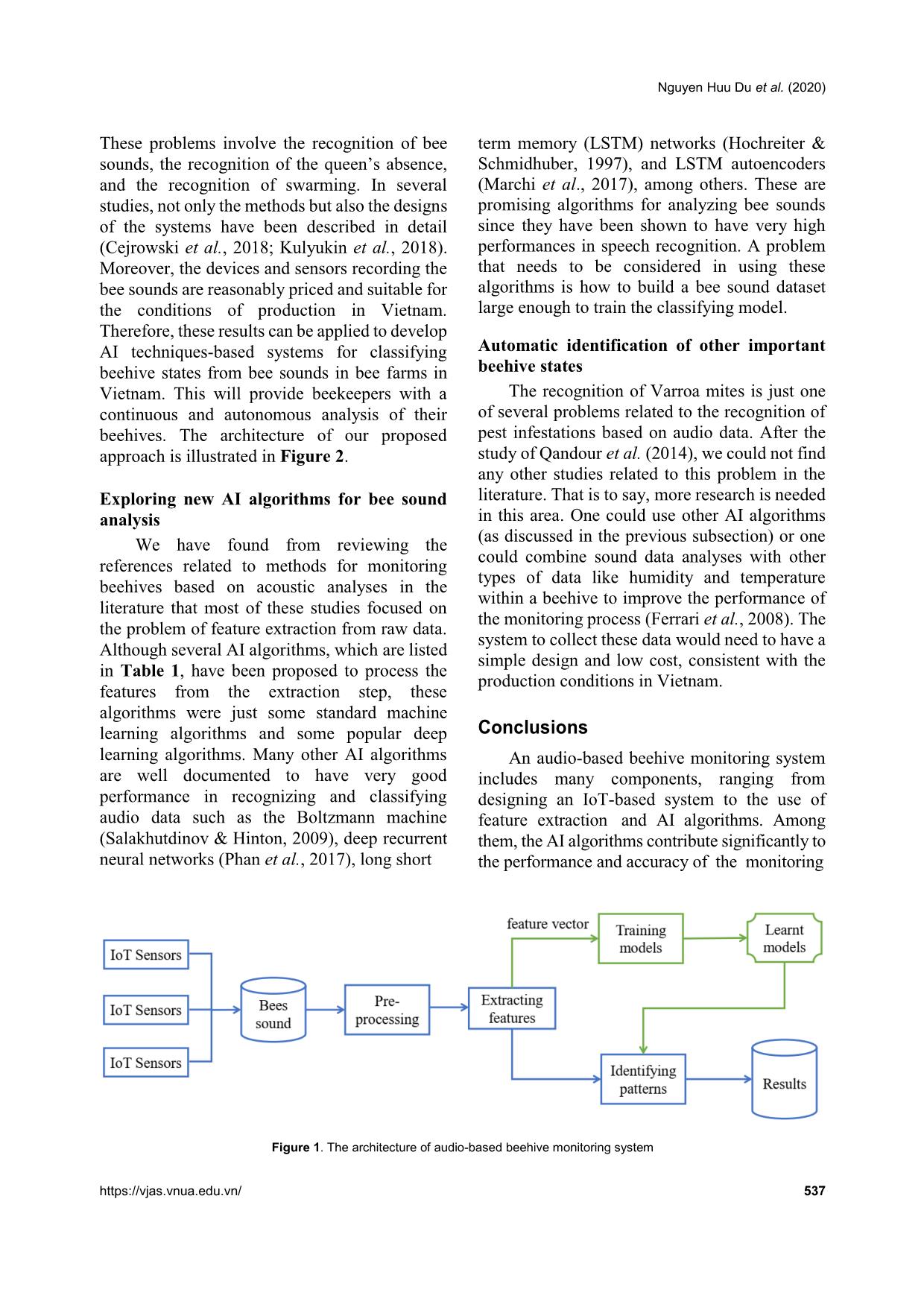
Trang 8
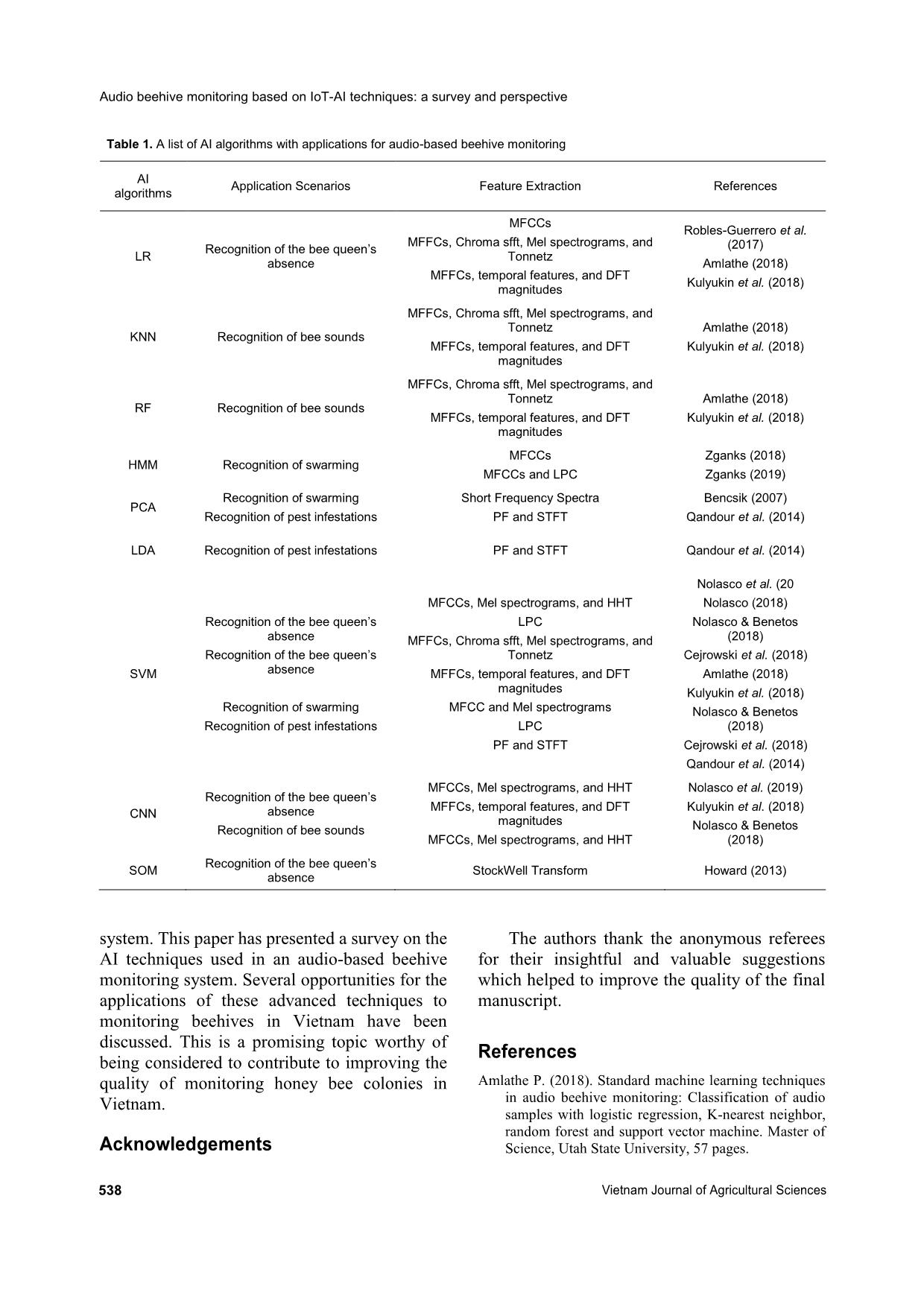
Trang 9
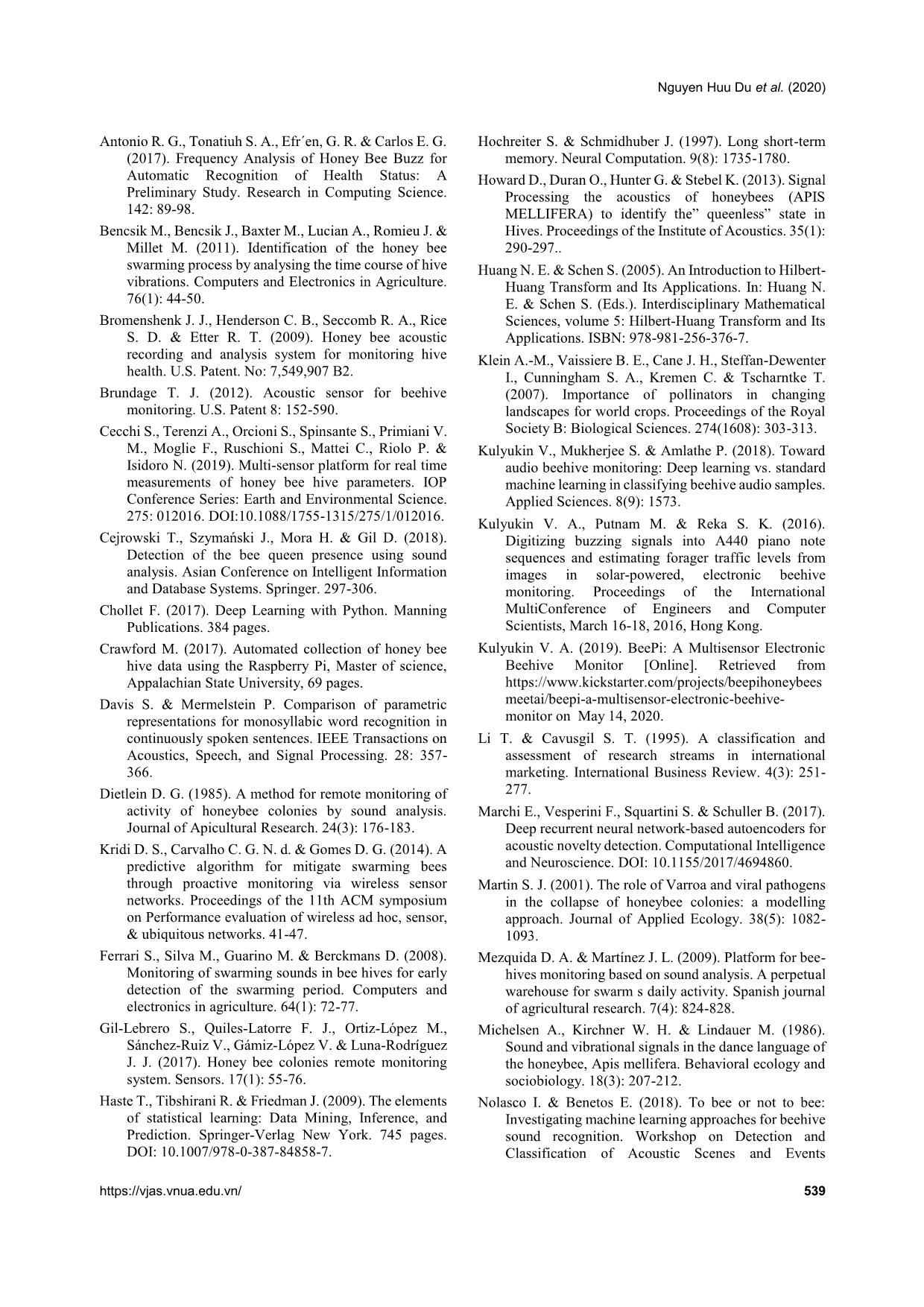
Trang 10
Tải về để xem bản đầy đủ
Tóm tắt nội dung tài liệu: Audio beehive monitoring based on IoT-Ai techniques: A survey and perspective

owski et al., 2018; Kulyukin et al., 2018). performances in speech recognition. A problem Moreover, the devices and sensors recording the that needs to be considered in using these bee sounds are reasonably priced and suitable for algorithms is how to build a bee sound dataset the conditions of production in Vietnam. large enough to train the classifying model. Therefore, these results can be applied to develop AI techniques-based systems for classifying Automatic identification of other important beehive states from bee sounds in bee farms in beehive states Vietnam. This will provide beekeepers with a The recognition of Varroa mites is just one continuous and autonomous analysis of their of several problems related to the recognition of beehives. The architecture of our proposed pest infestations based on audio data. After the approach is illustrated in Figure 2. study of Qandour et al. (2014), we could not find any other studies related to this problem in the Exploring new AI algorithms for bee sound literature. That is to say, more research is needed analysis in this area. One could use other AI algorithms We have found from reviewing the (as discussed in the previous subsection) or one could combine sound data analyses with other references related to methods for monitoring types of data like humidity and temperature beehives based on acoustic analyses in the within a beehive to improve the performance of literature that most of these studies focused on the monitoring process (Ferrari et al., 2008). The the problem of feature extraction from raw data. system to collect these data would need to have a Although several AI algorithms, which are listed simple design and low cost, consistent with the in Table 1, have been proposed to process the production conditions in Vietnam. features from the extraction step, these algorithms were just some standard machine learning algorithms and some popular deep Conclusions learning algorithms. Many other AI algorithms An audio-based beehive monitoring system are well documented to have very good includes many components, ranging from performance in recognizing and classifying designing an IoT-based system to the use of audio data such as the Boltzmann machine feature extraction and AI algorithms. Among (Salakhutdinov & Hinton, 2009), deep recurrent them, the AI algorithms contribute significantly to neural networks (Phan et al., 2017), long short the performance and accuracy of the monitoring Figure 1. The architecture of audio-based beehive monitoring system https://vjas.vnua.edu.vn/ 537 Audio beehive monitoring based on IoT-AI techniques: a survey and perspective Table 1. A list of AI algorithms with applications for audio-based beehive monitoring AI Application Scenarios Feature Extraction References algorithms MFCCs Robles-Guerrero et al. MFFCs, Chroma sfft, Mel spectrograms, and Recognition of the bee queen’s (2017) LR Tonnetz absence Amlathe (2018) MFFCs, temporal features, and DFT Kulyukin et al. (2018) magnitudes MFFCs, Chroma sfft, Mel spectrograms, and Tonnetz Amlathe (2018) KNN Recognition of bee sounds MFFCs, temporal features, and DFT Kulyukin et al. (2018) magnitudes MFFCs, Chroma sfft, Mel spectrograms, and Tonnetz Amlathe (2018) RF Recognition of bee sounds MFFCs, temporal features, and DFT Kulyukin et al. (2018) magnitudes MFCCs Zganks (2018) HMM Recognition of swarming MFCCs and LPC Zganks (2019) Recognition of swarming Short Frequency Spectra Bencsik (2007) PCA Recognition of pest infestations PF and STFT Qandour et al. (2014) LDA Recognition of pest infestations PF and STFT Qandour et al. (2014) Nolasco et al. (20 MFCCs, Mel spectrograms, and HHT Nolasco (2018) Recognition of the bee queen’s LPC Nolasco & Benetos absence MFFCs, Chroma sfft, Mel spectrograms, and (2018) Recognition of the bee queen’s Tonnetz Cejrowski et al. (2018) SVM absence MFFCs, temporal features, and DFT Amlathe (2018) magnitudes Kulyukin et al. (2018) Recognition of swarming MFCC and Mel spectrograms Nolasco & Benetos Recognition of pest infestations LPC (2018) PF and STFT Cejrowski et al. (2018) Qandour et al. (2014) MFCCs, Mel spectrograms, and HHT Nolasco et al. (2019) Recognition of the bee queen’s MFFCs, temporal features, and DFT Kulyukin et al. (2018) CNN absence magnitudes Recognition of bee sounds Nolasco & Benetos MFCCs, Mel spectrograms, and HHT (2018) Recognition of the bee queen’s SOM StockWell Transform Howard (2013) absence system. This paper has presented a survey on the The authors thank the anonymous referees AI techniques used in an audio-based beehive for their insightful and valuable suggestions monitoring system. Several opportunities for the which helped to improve the quality of the final applications of these advanced techniques to manuscript. monitoring beehives in Vietnam have been discussed. This is a promising topic worthy of References being considered to contribute to improving the quality of monitoring honey bee colonies in Amlathe P. (2018). Standard machine learning techniques Vietnam. in audio beehive monitoring: Classification of audio samples with logistic regression, K-nearest neighbor, random forest and support vector machine. Master of Acknowledgements Science, Utah State University, 57 pages. 538 Vietnam Journal of Agricultural Sciences Nguyen Huu Du et al. (2020) Antonio R. G., Tonatiuh S. A., Efr´en, G. R. & Carlos E. G. Hochreiter S. & Schmidhuber J. (1997). Long short-term (2017). Frequency Analysis of Honey Bee Buzz for memory. Neural Computation. 9(8): 1735-1780. Automatic Recognition of Health Status: A Howard D., Duran O., Hunter G. & Stebel K. (2013). Signal Preliminary Study. Research in Computing Science. Processing the acoustics of honeybees (APIS 142: 89-98. MELLIFERA) to identify the” queenless” state in Bencsik M., Bencsik J., Baxter M., Lucian A., Romieu J. & Hives. Proceedings of the Institute of Acoustics. 35(1): Millet M. (2011). Identification of the honey bee 290-297.. swarming process by analysing the time course of hive Huang N. E. & Schen S. (2005). An Introduction to Hilbert- vibrations. Computers and Electronics in Agriculture. Huang Transform and Its Applications. In: Huang N. 76(1): 44-50. E. & Schen S. (Eds.). Interdisciplinary Mathematical Bromenshenk J. J., Henderson C. B., Seccomb R. A., Rice Sciences, volume 5: Hilbert-Huang Transform and Its S. D. & Etter R. T. (2009). Honey bee acoustic Applications. ISBN: 978-981-256-376-7. recording and analysis system for monitoring hive Klein A.-M., Vaissiere B. E., Cane J. H., Steffan-Dewenter health. U.S. Patent. No: 7,549,907 B2. I., Cunningham S. A., Kremen C. & Tscharntke T. Brundage T. J. (2012). Acoustic sensor for beehive (2007). Importance of pollinators in changing monitoring. U.S. Patent 8: 152-590. landscapes for world crops. Proceedings of the Royal Cecchi S., Terenzi A., Orcioni S., Spinsante S., Primiani V. Society B: Biological Sciences. 274(1608): 303-313. M., Moglie F., Ruschioni S., Mattei C., Riolo P. & Kulyukin V., Mukherjee S. & Amlathe P. (2018). Toward Isidoro N. (2019). Multi-sensor platform for real time audio beehive monitoring: Deep learning vs. standard measurements of honey bee hive parameters. IOP machine learning in classifying beehive audio samples. Conference Series: Earth and Environmental Science. Applied Sciences. 8(9): 1573. 275: 012016. DOI:10.1088/1755-1315/275/1/012016. Kulyukin V. A., Putnam M. & Reka S. K. (2016). Cejrowski T., Szymański J., Mora H. & Gil D. (2018). Digitizing buzzing signals into A440 piano note Detection of the bee queen presence using sound sequences and estimating forager traffic levels from analysis. Asian Conference on Intelligent Information images in solar-powered, electronic beehive and Database Systems. Springer. 297-306. monitoring. Proceedings of the International Chollet F. (2017). Deep Learning with Python. Manning MultiConference of Engineers and Computer Publications. 384 pages. Scientists, March 16-18, 2016, Hong Kong. Crawford M. (2017). Automated collection of honey bee Kulyukin V. A. (2019). BeePi: A Multisensor Electronic hive data using the Raspberry Pi, Master of science, Beehive Monitor [Online]. Retrieved from Appalachian State University, 69 pages. https://www.kickstarter.com/projects/beepihoneybees Davis S. & Mermelstein P. Comparison of parametric meetai/beepi-a-multisensor-electronic-beehive- representations for monosyllabic word recognition in monitor on May 14, 2020. continuously spoken sentences. IEEE Transactions on Li T. & Cavusgil S. T. (1995). A classification and Acoustics, Speech, and Signal Processing. 28: 357- assessment of research streams in international 366. marketing. International Business Review. 4(3): 251- Dietlein D. G. (1985). A method for remote monitoring of 277. activity of honeybee colonies by sound analysis. Marchi E., Vesperini F., Squartini S. & Schuller B. (2017). Journal of Apicultural Research. 24(3): 176-183. Deep recurrent neural network-based autoencoders for Kridi D. S., Carvalho C. G. N. d. & Gomes D. G. (2014). A acoustic novelty detection. Computational Intelligence predictive algorithm for mitigate swarming bees and Neuroscience. DOI: 10.1155/2017/4694860. through proactive monitoring via wireless sensor Martin S. J. (2001). The role of Varroa and viral pathogens networks. Proceedings of the 11th ACM symposium in the collapse of honeybee colonies: a modelling on Performance evaluation of wireless ad hoc, sensor, approach. Journal of Applied Ecology. 38(5): 1082- & ubiquitous networks. 41-47. 1093. Ferrari S., Silva M., Guarino M. & Berckmans D. (2008). Mezquida D. A. & Martínez J. L. (2009). Platform for bee- Monitoring of swarming sounds in bee hives for early hives monitoring based on sound analysis. A perpetual detection of the swarming period. Computers and warehouse for swarm s daily activity. Spanish journal electronics in agriculture. 64(1): 72-77. of agricultural research. 7(4): 824-828. Gil-Lebrero S., Quiles-Latorre F. J., Ortiz-López M., Michelsen A., Kirchner W. H. & Lindauer M. (1986). Sánchez-Ruiz V., Gámiz-López V. & Luna-Rodríguez Sound and vibrational signals in the dance language of J. J. (2017). Honey bee colonies remote monitoring the honeybee, Apis mellifera. Behavioral ecology and system. Sensors. 17(1): 55-76. sociobiology. 18(3): 207-212. Haste T., Tibshirani R. & Friedman J. (2009). The elements Nolasco I. & Benetos E. (2018). To bee or not to bee: of statistical learning: Data Mining, Inference, and Investigating machine learning approaches for beehive Prediction. Springer-Verlag New York. 745 pages. sound recognition. Workshop on Detection and DOI: 10.1007/978-0-387-84858-7. Classification of Acoustic Scenes and Events https://vjas.vnua.edu.vn/ 539 Audio beehive monitoring based on IoT-AI techniques: a survey and perspective (DCASE), New York, USA, October 25-26, 2018: mechanism of flight guidance in honeybee swarms: 133-137. subtle guides or streaker bees? The Journal of Nolasco I. (2018). Audio-based beehive state recognition, Experimental Biology. 211(20): 3287-3295. Master thesis, Queen Mary University of London. Schurischuster S., Zambanini S., Kampel M. & Lamp B. Nolasco I., Terenzi A., Cecchi S., Orcioni S., Bear H. L. & (2016). Sensor study for monitoring varroa mites on Benetos E. (2019). Audio-based identification of honey bees (apis mellifera). Visual Observation and beehive states. IEEE International Conference on Analysis of Vertebrate and Insect Behavior Workshop, Acoustics, Speech and Signal Processing (ICASSP), Cancun Mexico, December 4, 2016. Brighton, UK, May 12 – 17, 2019: 8256-8260. Seeley T. D. & Tautz J. (2001). Worker piping in honey bee OSBeehives platform (2018). OSBeehives | BuzzBox Hive swarms and its role in preparing for liftoff. Journal of Health Monitor & Beekeeping App. Retrieved from Comparative Physiology. 187: 667-676. https://www.osbeehives.com on May 14, 2020. Tautz J. (2008). The Buzz about Bees: Biology of a Phan H., Koch P., Katzberg F., Maass M., Mazur R. & Superorganism. Springer, Berlin, Heidelberg. Mertins A. (2017). Audio scene classification with Terenzi A., Cecchi S., Orcioni S. & Piazza F. (2019). deep recurrent neural networks. arXiv preprint Features Extraction Applied to the Analysis of the arXiv:1703.04770. Sounds Emitted by Honey Bees in a Beehive. 11th Qandour A., Ahmad I., Habibi D. & Leppard M. (2014). International Symposium on Image and Signal Remote beehive monitoring using acoustic signals. Processing and Analysis (ISPA). 3-8. Acoustics Australia. 42(3): 204-209. Vancata I. (1995). Using acoustic technology to monitor Ramírez M., Prendas J. P., Travieso C. M., Calderón R. & your hives. American Bee Journal. 135(9): 615-618. Salas O. (2012). Detection of the mite Varroa Visscher P. K. & Seeley T. D. (2007). Coordinating a group destructor in honey bee cells by video sequence departure: who produces the piping signals on processing. 2012 IEEE 16th International Conference honeybee swarms? Behavioral Ecology and on Intelligent Engineering Systems (INES). IEEE. Sociobiology. 61(10): 1615-1621. 103-108. Zacepins A., Kviesis A., Stalidzans E., Liepniece M. & Ramsey M., Bencsik M. & Newton M. I. (2017). Long-term Jurijs Meitalovs (2016). Remote detection of the trends in the honeybee ‘whooping signal’ revealed by swarming of honey bee colonies by single-point automated detection. PLoS One. 12(7): e0181736. temperature monitoring. Biosystems Engineering. DOI: 10.1371/journal.pone.0171162. 148: 76-80. Raspberry Pi Foundation (2016). Raspberry Pi Products". Zacepins A., Kviesis A., Ahrendt P., Richter U., Tekin S. Retrieved from https://www.raspberrypi.org/products/ & Durgun M. (2016). Beekeeping in the future - Smart on May 14, 2020. apiary managemen. 17th International Carpathian Rittschof C. C. & Seeley T. D. (2008). The buzz-run: how Control Conference (ICCC). 808-812. honeybees signal ‘Time to go!’. Animal Behaviour. Zganks A. (2018). Acoustic monitoring and classification 75(1): 189-197. of bee swarm activity using MFCC feature extraction Salakhutdinov R. & Hinton G. (2009). Deep boltzmann and HMM acoustic modeling. ELEKTRO. 1-4. machines. Artificial intelligence and statistics. 448- Zganks A. (2019). Bee Swarm Activity Acoustic 455. Classification for an IoT-Based Farm Service. Sensors. Schultz K. M., Passino K. M. & Seeley T. D. (2008). The 20(1).: 21-35. DOI: 10.3390/s20010021. 540 Vietnam Journal of Agricultural Sciences
File đính kèm:
 audio_beehive_monitoring_based_on_iot_ai_techniques_a_survey.pdf
audio_beehive_monitoring_based_on_iot_ai_techniques_a_survey.pdf

